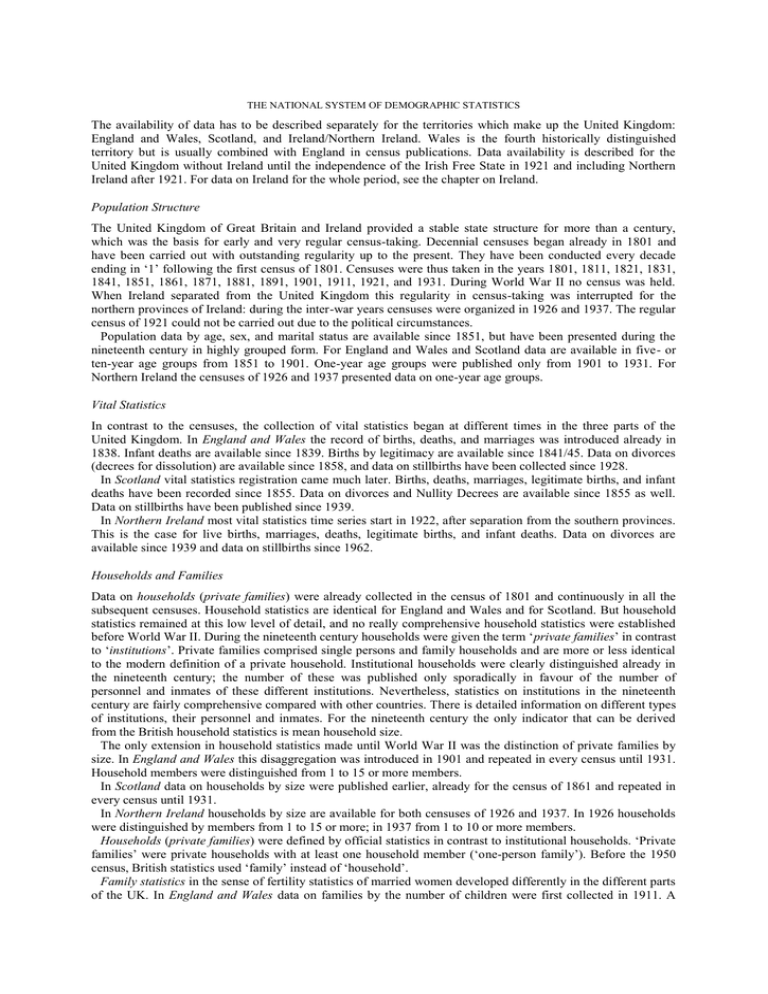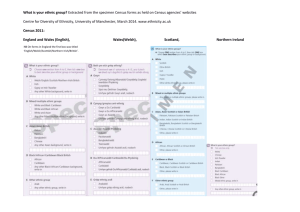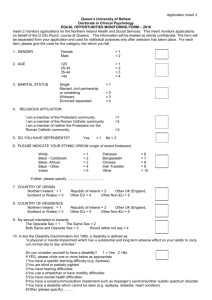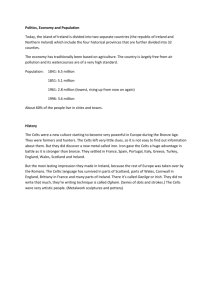uk8.doc
advertisement

THE NATIONAL SYSTEM OF DEMOGRAPHIC STATISTICS The availability of data has to be described separately for the territories which make up the United Kingdom: England and Wales, Scotland, and Ireland/Northern Ireland. Wales is the fourth historically distinguished territory but is usually combined with England in census publications. Data availability is described for the United Kingdom without Ireland until the independence of the Irish Free State in 1921 and including Northern Ireland after 1921. For data on Ireland for the whole period, see the chapter on Ireland. Population Structure The United Kingdom of Great Britain and Ireland provided a stable state structure for more than a century, which was the basis for early and very regular census-taking. Decennial censuses began already in 1801 and have been carried out with outstanding regularity up to the present. They have been conducted every decade ending in ‘1’ following the first census of 1801. Censuses were thus taken in the years 1801, 1811, 1821, 1831, 1841, 1851, 1861, 1871, 1881, 1891, 1901, 1911, 1921, and 1931. During World War II no census was held. When Ireland separated from the United Kingdom this regularity in census-taking was interrupted for the northern provinces of Ireland: during the inter-war years censuses were organized in 1926 and 1937. The regular census of 1921 could not be carried out due to the political circumstances. Population data by age, sex, and marital status are available since 1851, but have been presented during the nineteenth century in highly grouped form. For England and Wales and Scotland data are available in five- or ten-year age groups from 1851 to 1901. One-year age groups were published only from 1901 to 1931. For Northern Ireland the censuses of 1926 and 1937 presented data on one-year age groups. Vital Statistics In contrast to the censuses, the collection of vital statistics began at different times in the three parts of the United Kingdom. In England and Wales the record of births, deaths, and marriages was introduced already in 1838. Infant deaths are available since 1839. Births by legitimacy are available since 1841/45. Data on divorces (decrees for dissolution) are available since 1858, and data on stillbirths have been collected since 1928. In Scotland vital statistics registration came much later. Births, deaths, marriages, legitimate births, and infant deaths have been recorded since 1855. Data on divorces and Nullity Decrees are available since 1855 as well. Data on stillbirths have been published since 1939. In Northern Ireland most vital statistics time series start in 1922, after separation from the southern provinces. This is the case for live births, marriages, deaths, legitimate births, and infant deaths. Data on divorces are available since 1939 and data on stillbirths since 1962. Households and Families Data on households (private families) were already collected in the census of 1801 and continuously in all the subsequent censuses. Household statistics are identical for England and Wales and for Scotland. But household statistics remained at this low level of detail, and no really comprehensive household statistics were established before World War II. During the nineteenth century households were given the term ‘private families’ in contrast to ‘institutions’. Private families comprised single persons and family households and are more or less identical to the modern definition of a private household. Institutional households were clearly distinguished already in the nineteenth century; the number of these was published only sporadically in favour of the number of personnel and inmates of these different institutions. Nevertheless, statistics on institutions in the nineteenth century are fairly comprehensive compared with other countries. There is detailed information on different types of institutions, their personnel and inmates. For the nineteenth century the only indicator that can be derived from the British household statistics is mean household size. The only extension in household statistics made until World War II was the distinction of private families by size. In England and Wales this disaggregation was introduced in 1901 and repeated in every census until 1931. Household members were distinguished from 1 to 15 or more members. In Scotland data on households by size were published earlier, already for the census of 1861 and repeated in every census until 1931. In Northern Ireland households by size are available for both censuses of 1926 and 1937. In 1926 households were distinguished by members from 1 to 15 or more; in 1937 from 1 to 10 or more members. Households (private families) were defined by official statistics in contrast to institutional households. ‘Private families’ were private households with at least one household member (‘one-person family’). Before the 1950 census, British statistics used ‘family’ instead of ‘household’. Family statistics in the sense of fertility statistics of married women developed differently in the different parts of the UK. In England and Wales data on families by the number of children were first collected in 1911. A separate Volume XIII was published on the ‘Fertility of Marriage’ (no author given, 1917, 1923). An investigation into fertility was also conducted in 1921 but on a smaller scale (no author given, 1927: 175ff.). For Scotland no such data were published. In Northern Ireland the first special investigation of the fertility of marriages was produced in 1926. Remarks (also see introductory Table 6.1) The data for the UK refer to the territory of the United Kingdom as it was set up in 1801, that is, including Great Britain and Ireland from 1801 to 1921, and Great Britain and Northern Ireland only from 1922 to 1990. Data are also available for the constituent parts of the UK, that is, England and Wales, Scotland, Great Britain, Ireland from 1801–1921, and Eire from 1922 to the present.






